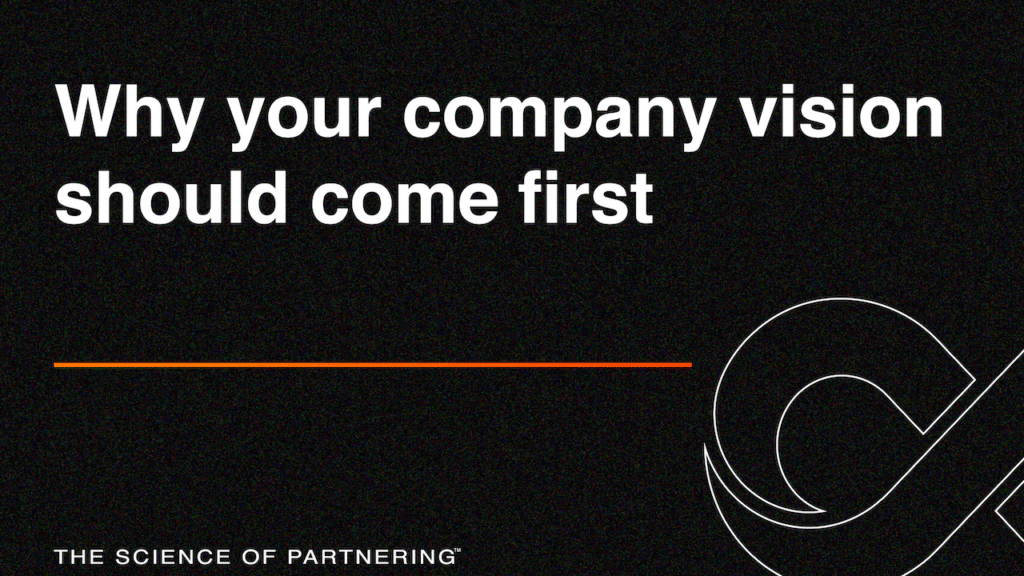The Vision Element of the Strategic Partner Leadership Model (SPLM) consists of three critical parts, your company’s “vision,” “mission,” and “core values.” Each component must be clearly identified by the company’s leadership and communicated throughout the organization. Ideally, members of your organization would have either helped create these vital components or they were hired into your company based upon the standards they represent.
The Vision Element (vision, mission, and core values) of the SPLM offers claims, statements, and beliefs that should be the DNA of every person, team, and decision that make up your organization. Talking about the mushy, squishy, softer sides of business and organizational management can be too abstract for certain individuals but know these are the critical ingredients that align employees to the same intended outcomes. Some folks, no matter how hard you try, simply do not believe that spending time on your company vision, mission, and core values will ever “move the needle.”
These old school thinkers believe the only thing that moves the ball down the field is, well, running the ball down the field. This approach may have a small amount of merit if you are talking about a company of one person, where alignment is not an issue. However, there is no doubt that as companies grow, there is an absolute necessity to clearly communicate direction and expectations to all employees, partners, and customers. These critical building blocks define your organization’s mere existence and its culture.
Your company’s Vision Element acts as the instant map and compass for your employees from top to bottom. To paint a word picture, envision an old Viking ship with 15 men on the left (port side) and 15 men on the right (starboard side). The muscular Vikings have long wooden oars stuck outside the windows (portals) rowing the ship forward. You can hear the crew leader calling out a cadence, yelling “row,” “row” every four seconds.
What would happen if the crew leader stopped yelling the cadence and the Vikings were not able to see each other’s actions? If they did anything at all, they would randomly row their oars at differing speeds and directions. You would witness pure chaos. This is exactly what happens when companies do not define, hire, and constantly communicate their vision, mission, and core values.
Not only do business leaders need to communicate the company’s aspirations and expectations, but they should first hire individuals based upon their company’s Vision Element. That is, you must start every employee’s journey with your company by proactively qualifying him/her for membership to be on your ship!
Your Company Vision
An organization’s vision is its long-term purpose, its ultimate reason for existence, the finish line goal. An organization’s vision is so lofty it will take a lifetime to achieve. Most visions are organized into a statement that describes a journey that will take 20 or more years to accomplish. Many executives say a vision should only be aspiration–not achievable.
Simon Sinek offers a concise description of a company vision statement in his best-selling book, Start with Why. Sinek suggests companies should offer a compelling vision that is focused on why the company exists, not what they produce or how they produce it. An upscale automobile manufacture may have a vision, “We exist to redefine affordable luxury and to force change to mediocrity–we will eliminate the status quo.” Vision, the long-range purpose, can be a powerful tool in getting your team and your partners “on the same page.”
Setting a meaningful company vision is an effective way to inspire employees and engage their sense of internal purpose.
Recent Gallop studies suggested the main reason why people left a job was not due to pay, but rather the lack of a sense of purpose and meaning. A company’s vision should provide a clear, motivating, and inspirational mental image of what ultimate success is for your organization.
Jim Collins and Jerry Porras authored the book, Built to Last. They conducted an intensive six-year study evaluating common characteristics of companies that achieved greatness for a period of decades. Porras called vision the “core driver of enduring organizational greatness” and claimed that every company that achieved long-term greatness had a strong and meaningful company vision that its employees knew and believed in.
A company vision should appeal to the emotions and inspire people to want to join its cause and contribute to its achievement. I am a firm believer in “taking my own medicine.” Before I hired our first employee, I felt compelled to identify PARTNERNOMICS’ company vision. I must admit we have made a couple slight adjustments over the years, but the core sentiment remains unchanged. The vision statement that we have posted in our office reads:
Vision of PARTNERNOMICS:
“To power the world’s most transformative partnerships.”
The recent and massive proliferation of video conferencing systems such as Zoom, Microsoft Teams, and Google Meet, professionals can collaborate without the limitation of geography. With the help of these amazing technologies and a few strategic partnerships, PARTNERNOMICS now has clients in more than 75 countries, and counting. The powerful combination of technology and partnerships is allowing us to attack our company vision, one client at a time.
There is no right or wrong vision statement for a company. In the end, if the vision statement provides a mental image of what your company is striving to accomplish and it inspires your employees and key partners to support your cause, it is effective. Vision statements are as diverse as the companies they represent. To illustrate this point, here are a few examples of company vision statements for you to consider.
Company: Apple
Vision: We believe that we are on the face of the earth to make great products and that’s not changing. We are constantly focusing on innovating. We believe in the simple not the complex. We believe that we need to own and control the primary technologies behind the products that we make and participate only in markets where we can make a significant contribution. We believe in saying no to thousands of projects, so that we can really focus on the few that are truly important and meaningful to us. We believe in deep collaboration and cross-pollination of our groups, which allow us to innovate in a way that others cannot. And frankly, we don’t settle for anything less than excellence in every group in the company, and we have the self- honesty to admit when we’re wrong and the courage to change. And I think regardless of who is in what job those values are so embedded in this company that Apple will do extremely well.
Company: Life is Good (clothing brand)
Vision: Spreading the power of optimism
Company: Barry-Wehmiller (heavy equipment manufacturer)
Vision: Use the power of business to build a better world
Apple has the longest vision statement that I have ever seen, and I think Life is Good may have the shortest. What is important is that the employees buy into the beliefs of the company, and they are emotionally invested to help the company accomplish its aspirations. Whether a vision takes 166 words (Apple) or five words (Life is Good) to accomplish this goal is irrelevant.


